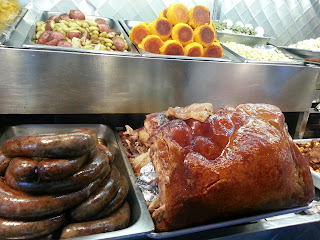eating ethnic foods in the boroughs make sense. i've been visiting my niece often and benny and i hit up jackson heights for colombian beef tongue and argentinian skirt steak. indonesian food in elmhurst isn't too shabby due to lack of options. and for that same reason sripraphai is also not bad considering NY THAI FOOD IS ABSOLUTE SHIT. just my opinion...
but then there's this...ecuadorian roast pork served only on the weekend by street vendors lined along side the junction boulevard stop off the 7 line. benny and i trekked out on saturday sans wife andk id....stuffing our face with chicaronnes and double fisting coconut milk and passion fruit drinks. we loved it so much, i brought dad the next day. the ladies speak zero english and we speak zero spanish. i pointed. and she nodded. i said delicioso...and she said si! and then we ate like amigo's in the car. =)
but then there's this...ecuadorian roast pork served only on the weekend by street vendors lined along side the junction boulevard stop off the 7 line. benny and i trekked out on saturday sans wife andk id....stuffing our face with chicaronnes and double fisting coconut milk and passion fruit drinks. we loved it so much, i brought dad the next day. the ladies speak zero english and we speak zero spanish. i pointed. and she nodded. i said delicioso...and she said si! and then we ate like amigo's in the car. =)
http://www.vablonsky.com/ecuadorian-food-in-queens-2/
The most recognizable offering (for those familiar with other versions of it) might very well be the roast pig (called “hornado”)—not because of the presence of a snout or a trotter that necessarily gives it away but because the shiny, amber skin and succulent flesh underneath is very reminiscent of Filipino “lechon” or Cantonese roast pig (like the kind that hangs in Chinatown eateries). Perhaps, the robust links (called “morcilla”)—looking universally like sausage of some kind—is the first item that people notice.
This cart, as with the other Ecuadorian carts nearby, serves so-called “Serrano food” (food of the mountain regions) in contrast to “Costeño food” (which originates from the coastal areas near the Pacific Ocean). It is very meat-centric. In fact, beyond the “hornado,” there is more pork. Pork is stewed (in an item called “sancocho”)—which, in its tray, looks grayish as if rescued from a soup stock; and, pork also is braised and fried. “Fritada de chancho” is a kind of braised pork that is cooked and browned in its own fat until the liquid has evaporated. Typically, these browned lumps of pork are sold with “llapingacho” (a yellowish-orange, seared potato patty filled with cheese) and “mote con habas” (an heirloom hominy made with oversized white corn kernels). Then, there are “chicharrónes,” which should not be confused with the snack food pork rinds that Americans may know by the same name. These are unabashed chunks of meaty pork belly that are fried until they are golden brown and the attached skin has become ultra-crispy. The chunks of pork belly are served on a bed of roasted corn kernels (larger than the North American variety) that resemble kernels of charred, unpopped popcorn.


















